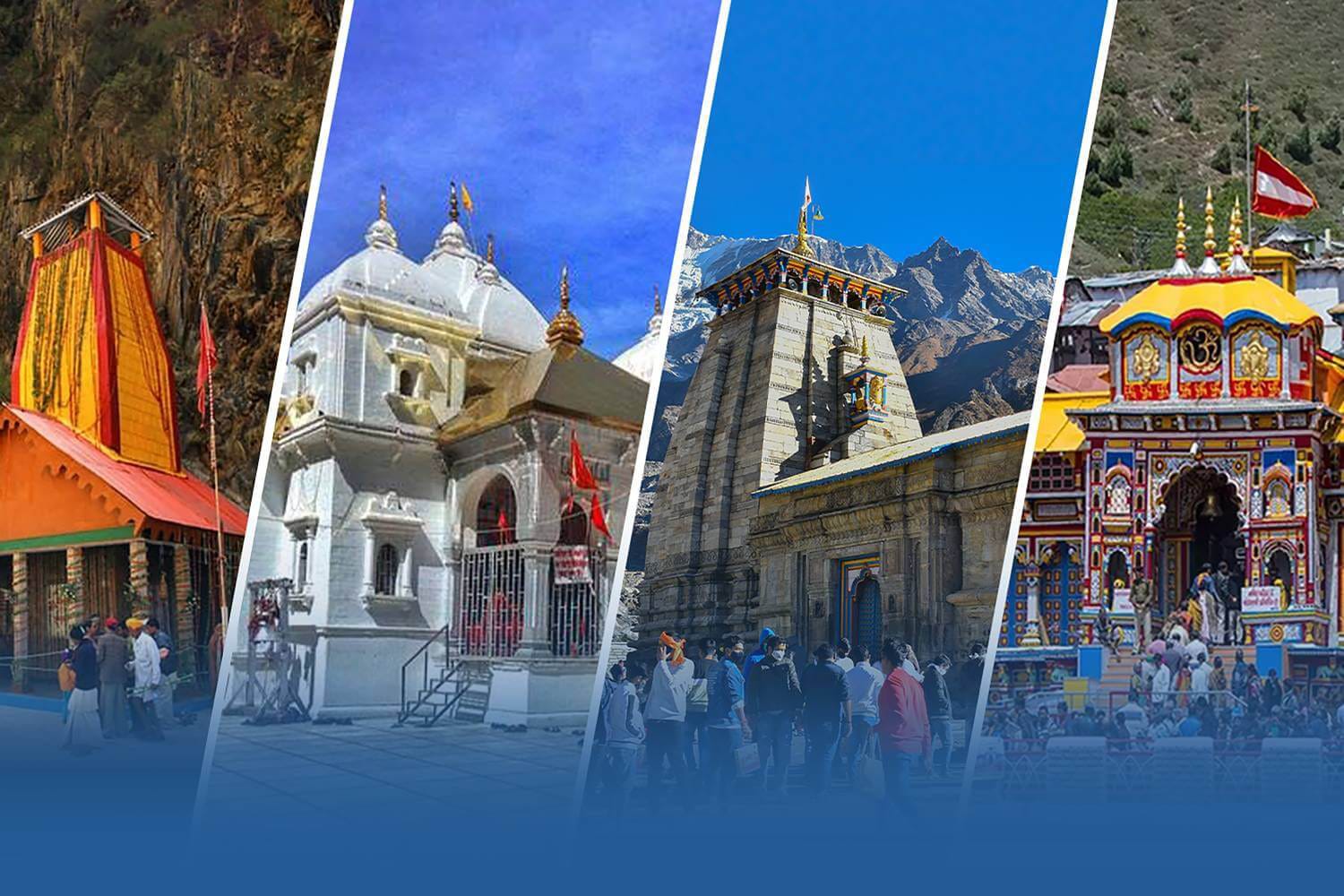- www.viewstartravels@gmail.com
- +91 9718892109 / +91 1146546390
CHAR DHAM YATRA
About HARIDWAR, KEDARNATH, BADRINATH, I, GANGOTRI & YAMUNOTR
ABOUT HARIDWAR
ABOUT BADRINATH
ABOUT KEDARNATH
ABOUT GANGOTRI
About Yamunotri
The fifth Jyotirlinga of Lord Shiva is in Uttarakhand. Its name is Kedarnath. This temple is also included in the Chardhams of Uttarakhand. The history of this abode of Lord Shiva is related to the incarnation of Lord Vishnu, Nar-Narayan, Pandavas and Adiguru Shankaracharya. This temple is in the Himalayan region, due to this it remains closed for about 6 months during winter season and is opened for devotees during summer season. Know the special things related to the fifth Jyotirlinga...
Day 1 - Delhi - Haridwar (Approx 250 Kms / 06 Hrs)
Upon arrival we will pick up you and drive to Haridwar, 06 hours journey by the road. Reach and check in at hotel, Evening visit Har-ki Pauri for Aarti ceremony of mother Ganges. Later return to hotel. A
Overnight stay at Hotel
Day 2 - Haridwar - Barkot (Approx 180 Kms / 6-7 Hrs)
This day after breakfast, check out from hotel and Barkot, 06-07 hours’ drive, check in at camp. An overnight stay. Barkot is an ideal destination to stay for pilgrims of Shri Yamunotri, It is situated 45 Kms before Yamunotri temple, from where paranomic views of the Bandar punch Peaks can be seen.
Overnight stay at Hotel
Day 3 - Barkot - Yamunotri - Barkot - (Approx 36 Kms drive & 6 Kms Trek one side)
Early morning after breakfast, drive to Janki chatti, start trek to Yamunotri 6 kms. You have an option to either walk or hire Pony or by Doli at your own cost.
After taking bath in Surya Kund (hot spring) visit Yamunotri temple ""Darshan"" and Pooja of pious ""Yamunaji"" at Divya Shila, Return to can an overnight stay.
Yamunotri Temple - Situated at 3290 meters above ocean level. The Yamunotri Dham is the first hallowed destination of the Chardham Yatra. This Dham is committed to Goddess Yamuna, who regarded be as a daughter of the Sun God, Surya Dev.According to the mythological stories and convictions, the Yamunotri Dham was an isolation of a sage Asti Muni. For the duration of his life, the Asti Muni every day showered in both Ganges and Yamuna. Be that as it may, in his old age he didn't have the enough energy to reach Gangotri, yet his great deeds paid off and a flood of Ganges showed up inverse to Yamunotri for him. This fanciful story adds to the otherworldly worth of the Dham.
Divya Shila : A rock pillar, worshipped before entering the Yamunotri Temple.
Overnight stay at Hotel
Day 4 - Barkot - Uttarkashi (Approx 155 Kms / 6-7 Hrs)
This morning after breakfast, check out from hotel and drive to Uttarkashi. On arrive check-in at the hotel. Later visit Vishwanath Temple, An overnight stay.
Day 5 - Uttarkashi - Gangotri - Uttarkashi (Approx 100 Kms / 03 Hrs one side)
This day after breakfast, we proceed to Gangotri Enroute enjoy picturesque Harsil valley, Bhagirathi River and the most magnificent view of the Himalayas. Reach at temple Darshan and perform pooja. Thereafter we drive back to hotel. Night stay.
Gangotri - As per The Hindu mythology, Goddess Ganga - the daughter of Lord Brahma, showed herself as a waterway to acquit the transgressions of King Bhagirathi’s forerunners, taking after his extreme retribution of a few centuries, and Lord Shiva got her into his tangled locks to minimize the gigantic effect of her fall. She came to be called Bhagirathi at her incredible source. Along the right back of Bhagirathi stands the sanctum of Gangotri devoted to the Goddess. Roosted at a stature of 3042 meters (10,000 ft), it was developed in the mid 18th century by a Gorkha Commander, Amar Singh Thapa.
Overnight stay at Hotel
Day 6 - Uttarkashi - Guptkashi (Approx 220 Kms / 09 Hrs)
This day after breakfast, check out from hotel and drive to Guptkashi reach and check in.
Overnight stay at Hotel
Day 7 - By Helicopter Kedarnath (Own)
This day Early morning at 6:30 report to helipad. After performing pooja and Darshan, fly down. Reach and later you will be transfer to hotel. Night stay
NOTE : You can also visit Kedarnath Ji by trek (20 kms /08-09 Hrs per side)
Early morning you will drive till sonprayag (vehicles allow till this point) from here you need to take local jeep/ Max to reach Gaurikund (3 km, on direct payment basis, approx INR 100 per person). Gaurikund – The trek start from this point to Kedarnath, which is long and beautiful man made trail. After reaching, performing pooja and Darshan. Later check in at hotel. Night stay at Kedarnath Kedarnath Temple The 1000 years old temple with a carved exterior is located in a courtyard protected by Nandi bull. This spot has great significance in the legendary Mahabharata epic. Inside the main sanctum is one of the 12 naturally formed 'Jyotirlingas' of India. The temple has carved shapes of the Pandavas, and Lord Shiva.
Overnight stay at Hotel
Day 8 - Kedarnath - Gaurikund / Sitapur
At early morning trek down to the Gaurikund reach and take Local Jeep to the Sonprayag and we will pick- up you and Transfer you to the Hotel.
Overnight stay at Hotel
Day 9 - Guptkashi - Chopta - Badrinath (Approx 250 Kms / 8-9 Hrs)
This day after breakfast, check out from hotel and drive to Badrinath via visiting Chopta, it is known mini Switzerland and Medical forest. On arrive check-in at hotel.
Evening : Visit at Badrinath temple. If time permits. Badrinath temple - It's so great to take in the way that this sacrosanct destination which is being dedicated to Lord Vishnu has been committed to humankind. The area where Lord Vishnu pondered under a Badri tree for thousand unremitting years and taught us a definitive method for welfare of humankind is exceptional on the planet. Today, this temple is considered as one of the holiest Hindu temples and is additionally one of the 108 Divya Desams, sacred holy places for Vaishnavites.
Overnight stay at Hotel
Day 10 - Badrinath - Rudraprayag (Approx 160 Kms / 06 Hrs)
Today after bath in the Taptkund visit & Darshan of Badrivishal. Brahamakamal is significant for Pinddan Shraddh of ancestors (Pitrus). There are other interesting sightseeing spot like Mana, Vyas Gufa, Maatamoorti, Bhimkund and the ""Mukh"" of the Saraswati River. Just within the three kms of Badrinathjee. Later drive to Rudraprayag. On arrive check –in at hotel and night stay.
Tapt-Kund - Just beneath the Shree Badrinath Ji temple lies the Tapt Kund hot sulfur spring that has a high therapeutic worth. It is a freshwater pool with the washing region of 16.1/2 feet by 14.1/4 feet. Despite the fact that the typical temperature of the spring is 55°c, the temperature of water continues expanding continuously amid the day. A dunk in Tapt Kund is viewed as a decent restorative cure for skin illnesses. Narad Kund - Narad Kund is arranged close Tapt Kund. It is accepted that the Badrinath icon was acquired from this Kund, Narad Kund boiling hot water spring is situated under the Garur Shila and holds a therapeutic worth. Fans take a plunge in this Kund before entering the Badrinath sanctuary for Darshan of Lord Badrinath.
Vyas & Ganesh-Gufa - Vyas & Ganesh-Gufa cavern is situated in the Mana Village alongside numerous different caverns. It is accepted that in this cavern Ved Vyas directed his acclaimed epic of Mahabharata to Ganesh and accordingly it has been named Vyas Gufa. There is an icon of Ved Vyas indicated composition the granth (epic book) inside this hole.
Beginning Source of Saraswati River - Manibhadrapur which is known as Mana village, the beginning source of river Saraswati. Bhimpul (bridge) according to myth it is build by Bhima during period of the Mahabharata.
Overnight stay at Hotel
Day 11 - Rudraprayag - Haridwar (Approx 165 Kms / 06 hrs)
This day after breakfast, drive to Haridwar via Rishikesh local sightseeing like Ram Jhula, Laxman Jhula, Triveni ghat temples and Ashrams. Check in at hotel.
Overnight stay at Hotel
Day 12 - Haridwar - Delhi (Approx 250 Kms / 06 hrs)
Breakfast at hotel, check out and drive to Delhi.
Inclusions
01 Night accommodation in Haridwar
![]()
![]()
![]()
![]()
![]()
![]()
![]()
![]()
![]()
![]()
![]()
![]()
![]()
![]()
![]()
![]()
![]()
![]()


 Zero Processing Fee
Zero Processing Fee

